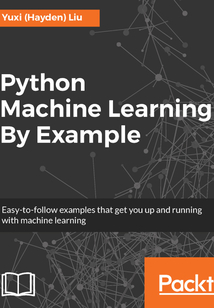目錄(145章)
倒序
- coverpage
- Title Page
- Credits
- About the Author
- About the Reviewer
- www.PacktPub.com
- Customer Feedback
- Preface
- What this book covers
- What you need for this book
- Who this book is for
- Conventions
- Reader feedback
- Customer support
- Downloading the example code
- Errata
- Piracy
- Questions
- Getting Started with Python and Machine Learning
- What is machine learning and why do we need it?
- A very high level overview of machine learning
- A brief history of the development of machine learning algorithms
- Generalizing with data
- Overfitting underfitting and the bias-variance tradeoff
- Avoid overfitting with cross-validation
- Avoid overfitting with regularization
- Avoid overfitting with feature selection and dimensionality reduction
- Preprocessing exploration and feature engineering
- Missing values
- Label encoding
- One-hot-encoding
- Scaling
- Polynomial features
- Power transformations
- Binning
- Combining models
- Bagging
- Boosting
- Stacking
- Blending
- Voting and averaging
- Installing software and setting up
- Troubleshooting and asking for help
- Summary
- Exploring the 20 Newsgroups Dataset with Text Analysis Algorithms
- What is NLP?
- Touring powerful NLP libraries in Python
- The newsgroups data
- Getting the data
- Thinking about features
- Visualization
- Data preprocessing
- Clustering
- Topic modeling
- Summary
- Spam Email Detection with Naive Bayes
- Getting started with classification
- Types of classification
- Applications of text classification
- Exploring naive Bayes
- Bayes' theorem by examples
- The mechanics of naive Bayes
- The naive Bayes implementations
- Classifier performance evaluation
- Model tuning and cross-validation
- Summary
- News Topic Classification with Support Vector Machine
- Recap and inverse document frequency
- Support vector machine
- The mechanics of SVM
- Scenario 1 - identifying the separating hyperplane
- Scenario 2 - determining the optimal hyperplane
- Scenario 3 - handling outliers
- The implementations of SVM
- Scenario 4 - dealing with more than two classes
- The kernels of SVM
- Choosing between the linear and RBF kernel
- News topic classification with support vector machine
- More examples - fetal state classification on cardiotocography with SVM
- Summary
- Click-Through Prediction with Tree-Based Algorithms
- Brief overview of advertising click-through prediction
- Getting started with two types of data numerical and categorical
- Decision tree classifier
- The construction of a decision tree
- The metrics to measure a split
- The implementations of decision tree
- Click-through prediction with decision tree
- Random forest - feature bagging of decision tree
- Summary
- Click-Through Prediction with Logistic Regression
- One-hot encoding - converting categorical features to numerical
- Logistic regression classifier
- Getting started with the logistic function
- The mechanics of logistic regression
- Training a logistic regression model via gradient descent
- Click-through prediction with logistic regression by gradient descent
- Training a logistic regression model via stochastic gradient descent
- Training a logistic regression model with regularization
- Training on large-scale datasets with online learning
- Handling multiclass classification
- Feature selection via random forest
- Summary
- Stock Price Prediction with Regression Algorithms
- Brief overview of the stock market and stock price
- What is regression?
- Predicting stock price with regression algorithms
- Feature engineering
- Data acquisition and feature generation
- Linear regression
- Decision tree regression
- Support vector regression
- Regression performance evaluation
- Stock price prediction with regression algorithms
- Summary
- Best Practices
- Machine learning workflow
- Best practices in the data preparation stage
- Best practice 1 - completely understand the project goal
- Best practice 2 - collect all fields that are relevant
- Best practice 3 - maintain consistency of field values
- Best practice 4 - deal with missing data
- Best practices in the training sets generation stage
- Best practice 5 - determine categorical features with numerical values
- Best practice 6 - decide on whether or not to encode categorical features
- Best practice 7 - decide on whether or not to select features and if so how
- Best practice 8 - decide on whether or not to reduce dimensionality and if so how
- Best practice 9 - decide on whether or not to scale features
- Best practice 10 - perform feature engineering with domain expertise
- Best practice 11 - perform feature engineering without domain expertise
- Best practice 12 - document how each feature is generated
- Best practices in the model training evaluation and selection stage
- Best practice 13 - choose the right algorithm(s) to start with
- Naive Bayes
- Logistic regression
- SVM
- Random forest (or decision tree)
- Neural networks
- Best practice 14 - reduce overfitting
- Best practice 15 - diagnose overfitting and underfitting
- Best practices in the deployment and monitoring stage
- Best practice 16 - save load and reuse models
- Best practice 17 - monitor model performance
- Best practice 18 - update models regularly
- Summary 更新時(shí)間:2021-07-02 22:57:40
推薦閱讀
- 案例式C語言程序設(shè)計(jì)
- PyTorch自動(dòng)駕駛視覺感知算法實(shí)戰(zhàn)
- MATLAB 2020 從入門到精通
- Java應(yīng)用開發(fā)技術(shù)實(shí)例教程
- Swift Playgrounds少兒趣編程
- 機(jī)器學(xué)習(xí)與R語言實(shí)戰(zhàn)
- SQL Server實(shí)用教程(SQL Server 2008版)
- 計(jì)算機(jī)應(yīng)用基礎(chǔ)案例教程
- Learning AWS
- Principles of Strategic Data Science
- Building Dynamics CRM 2015 Dashboards with Power BI
- Python 3 數(shù)據(jù)分析與機(jī)器學(xué)習(xí)實(shí)戰(zhàn)
- Hands-On Robotics Programming with C++
- Building Microservices with Go
- 虛擬現(xiàn)實(shí):引領(lǐng)未來的人機(jī)交互革命
- Swift iOS Programming for Kids
- The Python Apprentice
- 狼書(卷2):Node.js Web應(yīng)用開發(fā)
- Python輕松學(xué):爬蟲、游戲與架站
- Node Web Development(Second Edition)
- Android 5 Programming by Example
- Vue.js+Node.js開發(fā)實(shí)戰(zhàn):從入門到項(xiàng)目上線
- 區(qū)塊鏈原理、技術(shù)及應(yīng)用
- Scratch 3.0少兒編程從入門到精通(全彩版)
- C語言程序設(shè)計(jì)習(xí)題解析與實(shí)驗(yàn)指導(dǎo)(第3版)
- 亮劍Visual C++項(xiàng)目開發(fā)案例導(dǎo)航
- 智能優(yōu)化算法及其MATLAB實(shí)例(第3版)
- C語言程序設(shè)計(jì)教程
- C#碼農(nóng)筆記:從第一行代碼到項(xiàng)目實(shí)戰(zhàn)
- 狼書(卷3):Node.js高級(jí)技術(shù)


